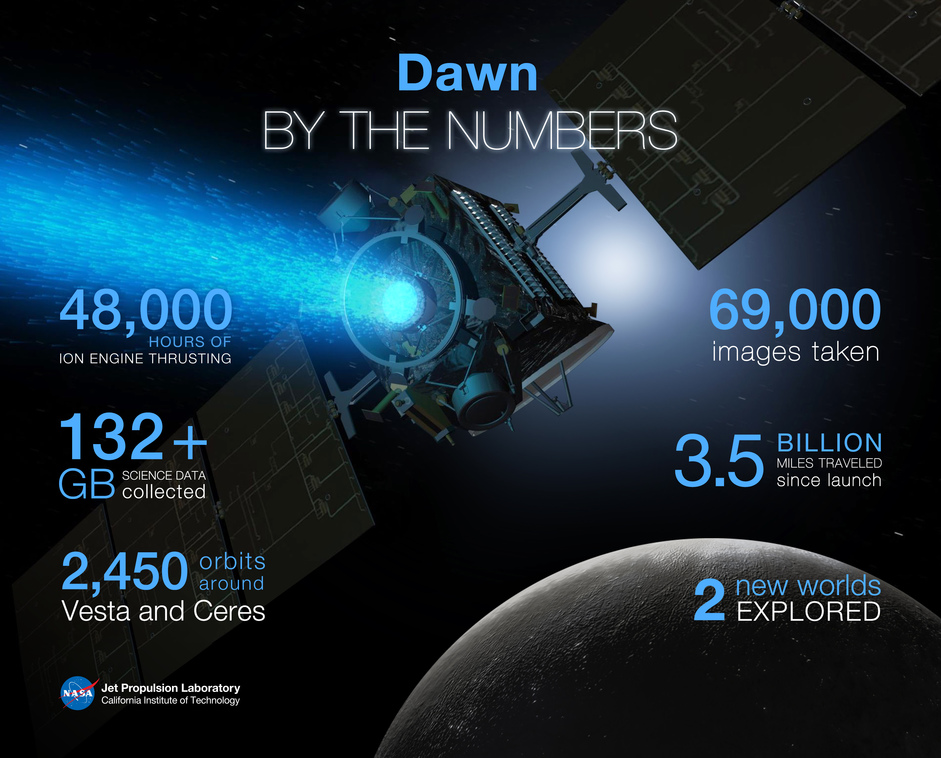NASA's Dawn Probe Ends Primary Mission, May Visit 3rd Cosmic Object

NASA's Dawn spacecraft has completed its historic primary mission, during which the probe became the first ever to visit a dwarf planet and the first to orbit two different bodies beyond the Earth-moon system.
Dawn's primary mission came to an end Thursday (June 30). But the spacecraft isn't shutting down; Dawn is still studying the dwarf planet Ceres from orbit, and the probe may soon head out to visit a third cosmic object, if NASA approves a proposed extended mission.
The $467 million Dawn mission launched in September 2007 to study Vesta and Ceres, the two largest objects in the main asteroid belt between Mars and Jupiter.
Dawn orbited the 330-mile-wide (530 kilometers) Vesta from July 2011 through September 2012, and the probe has been circling the 590-mile-wide (950 km) Ceres since March 2015.
Dawn's observations are helping researchers better understand how these two very different worlds formed and evolved, mission team members have said.
"Dawn has revealed that while Vesta is a dry body, Ceres could be as much as 25 percent water ice by mass," NASA officials said in a statement. "Dawn also discovered many intriguing features at both bodies — Vesta is home to a mountain whose height is more than twice that of Mount Everest, and Ceres has a crater called Occator with mysterious bright features that continue to spark scientific investigation."
During the course of its primary mission, Dawn traveled more than 3.5 billion miles (5.6 billion km), orbited Vesta and Ceres a combined 2,450 times and beamed home a total of 69,000 images of both bodies, NASA officials said.
Breaking space news, the latest updates on rocket launches, skywatching events and more!
The spacecraft's work isn't done, however. Dawn is still observing Ceres, and mission team members recently proposed to fly the probe to a third object in the asteroid belt on an extended mission. (Dawn scientists have not revealed the identity of the targeted body.)
NASA must decide soon whether or not to approve the extension; if Dawn doesn't leave Ceres by July 12, the spacecraft won't have enough hydrazine fuel left to make the journey to the third object, Spaceflight Now reported yesterday (June 30).
If Dawn stays put at Ceres, it should have enough hydrazine to keep operating until early 2017, mission officials have said.
Follow Mike Wall on Twitter @michaeldwall and Google+. Follow us @Spacedotcom, Facebook or Google+. Originally published on Space.com.

Michael Wall is a Senior Space Writer with Space.com and joined the team in 2010. He primarily covers exoplanets, spaceflight and military space, but has been known to dabble in the space art beat. His book about the search for alien life, "Out There," was published on Nov. 13, 2018. Before becoming a science writer, Michael worked as a herpetologist and wildlife biologist. He has a Ph.D. in evolutionary biology from the University of Sydney, Australia, a bachelor's degree from the University of Arizona, and a graduate certificate in science writing from the University of California, Santa Cruz. To find out what his latest project is, you can follow Michael on Twitter.

